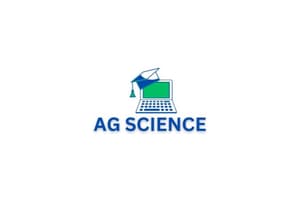Podcast
Questions and Answers
A farmer wants to improve the milk production of their cows. Which selective breeding strategy would be MOST effective?
A farmer wants to improve the milk production of their cows. Which selective breeding strategy would be MOST effective?
- Randomly breeding cows without considering their milk production history.
- Breeding cows with bulls known for their meat production to create dual-purpose offspring.
- Breeding cows that consistently produce high milk yields with bulls whose female offspring also show high milk yields. (correct)
- Using genetic modification techniques instead of selective breeding.
Which of the following is a POTENTIAL disadvantage associated with selective breeding?
Which of the following is a POTENTIAL disadvantage associated with selective breeding?
- Reduction in genetic diversity within a species. (correct)
- Higher yields and improved nutrient balance in crops.
- Increased resistance to diseases and parasites in livestock.
- Enhanced adaptation to harsh climates for both plants and animals.
Artificial insemination has become a widely used technique in livestock breeding. What is a PRIMARY benefit of this technology?
Artificial insemination has become a widely used technique in livestock breeding. What is a PRIMARY benefit of this technology?
- It allows a single male to fertilize a large number of females across different locations. (correct)
- It ensures the offspring are resistant to all diseases.
- It guarantees offspring will have superior traits.
- It eliminates the risk of genetic mutations in offspring.
A scientist is using plasmids in genetic modification. What is the MAIN reason plasmids are valuable tools in this process?
A scientist is using plasmids in genetic modification. What is the MAIN reason plasmids are valuable tools in this process?
In genetic modification, which enzyme is responsible for cutting DNA molecules at specific sequences?
In genetic modification, which enzyme is responsible for cutting DNA molecules at specific sequences?
What is the role of DNA ligase in the process of producing genetically modified organisms?
What is the role of DNA ligase in the process of producing genetically modified organisms?
A researcher aims to insert a specific gene into a plasmid. Which type of ends, created by restriction enzymes, would be MOST useful for ensuring the gene is inserted in the correct orientation?
A researcher aims to insert a specific gene into a plasmid. Which type of ends, created by restriction enzymes, would be MOST useful for ensuring the gene is inserted in the correct orientation?
Which of the following BEST describes 'recombinant DNA'?
Which of the following BEST describes 'recombinant DNA'?
Which of the following is a direct benefit of using a vector with multiple points of contact in genetic modification?
Which of the following is a direct benefit of using a vector with multiple points of contact in genetic modification?
A biologist is using a plasmid to transfer a specific gene into a bacterium. What is the primary reason the biologist would choose a plasmid for this process?
A biologist is using a plasmid to transfer a specific gene into a bacterium. What is the primary reason the biologist would choose a plasmid for this process?
A genetically modified bacterium is created to produce a human protein. How is this bacterium then used as a vector?
A genetically modified bacterium is created to produce a human protein. How is this bacterium then used as a vector?
Which of the following outcomes is LEAST likely to be achieved through genetic modification of animals?
Which of the following outcomes is LEAST likely to be achieved through genetic modification of animals?
A farmer wants to improve the resilience of their crops to drought conditions. Which genetic modification would be MOST effective for this purpose?
A farmer wants to improve the resilience of their crops to drought conditions. Which genetic modification would be MOST effective for this purpose?
A pharmaceutical company uses GM bacteria to produce a vaccine antigen. What is the direct purpose of injecting this antigen into a patient?
A pharmaceutical company uses GM bacteria to produce a vaccine antigen. What is the direct purpose of injecting this antigen into a patient?
How does an increase in temperature typically affect the rate of diffusion, and why?
How does an increase in temperature typically affect the rate of diffusion, and why?
In plant cells, what condition does 'turgid' describe, and what causes this state?
In plant cells, what condition does 'turgid' describe, and what causes this state?
In active transport, what role does ATP play in moving substances across the cell membrane against their concentration gradient?
In active transport, what role does ATP play in moving substances across the cell membrane against their concentration gradient?
Why is active transport necessary for cells to uptake glucose and amino acids when their concentration is lower outside the cell compared to inside?
Why is active transport necessary for cells to uptake glucose and amino acids when their concentration is lower outside the cell compared to inside?
Flashcards
Selective Breeding
Selective Breeding
Breeding organisms to pass on selected genetic traits.
Advantages of Selective Plant Breeding
Advantages of Selective Plant Breeding
Higher yields, disease resistance, better nutrients.
Advantages of Selective Animal Breeding
Advantages of Selective Animal Breeding
More meat/milk, better fur, disease resistance.
Reasons to Limit Selective Breeding
Reasons to Limit Selective Breeding
Signup and view all the flashcards
Recombinant DNA
Recombinant DNA
Signup and view all the flashcards
Cloning
Cloning
Signup and view all the flashcards
Vector DNA
Vector DNA
Signup and view all the flashcards
Restriction Endonucleases
Restriction Endonucleases
Signup and view all the flashcards
Vector (in GM)
Vector (in GM)
Signup and view all the flashcards
Bacteriophage
Bacteriophage
Signup and view all the flashcards
Uses of Genetic Modification
Uses of Genetic Modification
Signup and view all the flashcards
Diffusion
Diffusion
Signup and view all the flashcards
Osmosis
Osmosis
Signup and view all the flashcards
Plasmolysed
Plasmolysed
Signup and view all the flashcards
Flaccid
Flaccid
Signup and view all the flashcards
Turgid
Turgid
Signup and view all the flashcards
Active Transport
Active Transport
Signup and view all the flashcards
Transporter Proteins (Pumps)
Transporter Proteins (Pumps)
Signup and view all the flashcards
Study Notes
- Selective breeding is the intentional breeding of organisms to pass on selected genetic traits and produce desirable traits.
Plant Selective Breeding
- Crop advantages include higher yields, disease resistance, insect pest damage resistance, hardiness, and better nutrient balance.
Animal Selective Breeding
- Since the 1950s, artificial insemination has become widely available for livestock
- Semen from prized bulls can fertilize thousands of cows via artificial insemination.
- Advantages include increased meat, milk, egg production, better fur, more offspring, increased disease resistance, and hardiness.
- Reasons to limit/stop selective breeding: loss of species variety, no control over mutations, animal discomfort, offspring with different traits, genetic depression, and environmental risks.
Genetic Modification
- Recombinant DNA is DNA formed by combining genetic material from different sources.
- Recombinant refers to containing genetic material from different sources.
- Cloning is the process of producing genetically identical copies of organisms or cells.
- Foreign DNA is from a different source than the organism.
- Vector DNA is a DNA molecule carrying foreign genetic material into a cell.
- Bacteria have chromosomal DNA and smaller circular DNA called plasmids.
- Plasmids are used in GM because they contain the same genetic material as chromosomal DNA and are self-replicating.
- Restriction endonucleases (enzymes) cut DNA molecules at specific points.
- Ligases (DNA ligases) join the cut ends of DNA molecules.
- Sticky ends are more useful because they ensure the DNA fragment is inserted correctly.
- A vector transfers a gene from any cell into a bacterium by inserting the gene into a plasmid.
- Bacteriophage: A virus that attacks a bacterium and injects its own DNA causing the bacterium to produce many virus particles.
Uses of GM Animals
- GM can improve animals for making human proteins, increased production of milk and meat, increased resistance to disease and harsh temperatures and production of organs for transplantation
Uses of GM Plants
- GM improves plants through extended shelf life, herbicide/freezing/pest/pathogen resistance, increased vitamin production, heat/drought/salt resistance, and better nutrient balance.
Genetic Modification Uses
- Genetic modification is used for human insulin production (previously from animals).
- Enzymes made by GM can work at higher temperatures for washing powders.
- The food industry uses GM in reactions converting sugars (glucose to fructose).
- GM bacteria produce human growth hormone for children lacking it.
- Bovine Somatotropin (growth hormone in cattle) increases milk and meat production from cattle from hormones made by GM.
- Human vaccines use GM to create antigens in bacteria that are injected, resulting in antibody production
Osmosis, Diffusion & Active Transport
- In biology, transport refers to the act or the means by which a molecule or ion is moved across the cell membrane or via the bloodstream.
- Passive transport does not require energy.
- Active transport requires energy.
Diffusion
- Diffusion is the movement of a substance from an area of high concentration to an area of low concentration
- Diffusion rate increases with a steeper concentration gradient and larger surface area to volume ratio.
- Diffusion rate decreases with greater distance.
- Diffusion rate increases at higher temps. This is because increased temperature will cause increased kinetic energy.
Osmosis
- Osmosis involves the diffusion of water.
- Semipermeable/selectively permeable/partially permeable membranes allow liquids or gases to pass through.
- Water moves from high to low concentration to balance concentrations in osmosis.
- Plasmolysed: Shrunken or reduced, caused by decreased pressure.
- Flaccid: Soft or loose, caused by equal pressure.
- Turgid: Swollen, packed, or condensed, caused by increased pressure.
Active Transport
- Active transport occurs when a cell intakes a substance against the concentration gradient.
- Active transport is often explained as a pumping action.
- Pumps are large proteins located in the cell membrane and are driven by ATP.
- Glucose and amino acids are often transported into cells against their concentration gradient, using active transport.
- Active transport uses transporter proteins (pumps) in the cell membrane.
- The protein pump needs energy in order to change shape.
Studying That Suits You
Use AI to generate personalized quizzes and flashcards to suit your learning preferences.
Description
Explore selective breeding in plants and animals, including artificial insemination for livestock. Understand the advantages like higher yields and disease resistance, as well as the limitations, such as loss of species variety and environmental risks. Definition of Recombinant DNA.




